Duiker W.J., Spielvogel J.J. The Essential World History. Volume 1: To 1800
Подождите немного. Документ загружается.

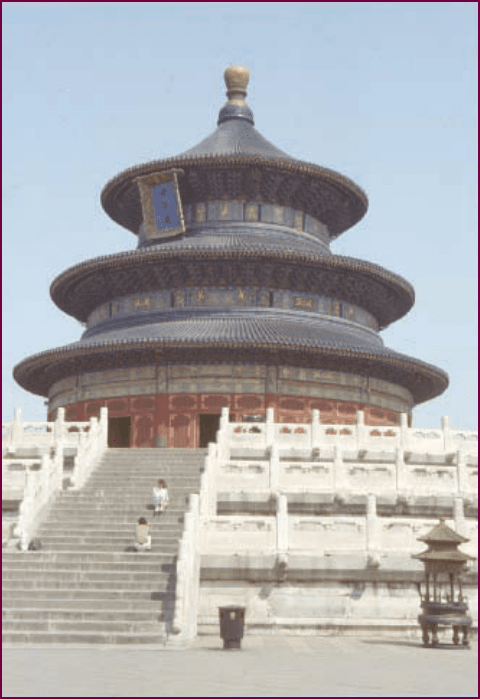
Hongwu and Yongle; under the Qin g, they would be
Kangxi (K’ang Hsi) and Qianlong (Ch’ien Lung). The two
Qing monarchs ruled China for well over a century , from
the middle of the seventeenth century to the end of the
eightee nth, and were responsible for much of the greatness
of Manchu China.
The Reign of Kangxi Kangxi (1661--1722) was arguably
the greatest ruler in Chinese history. Ascending to the
throne at the age of seven, he was blessed with diligence,
political astuteness, and a strong character and began to
take charge of Qing administration while still an adoles-
cent. During the six decades of his reign, Kangxi not only
stabilized imperial rule by pacifying the restive peoples
along the northern and western frontiers but also
managed to make the dynasty acceptable to the general
population. As an active patron of arts and letters, he
cultivated the support of scholars through a number of
major projects.
During Kangxi’s reign, the activities of the Western
missionaries, Dominicans and Franciscans as well as
Jesuits, reached their height. The emperor was quite
tolerant of the Christians, and several Jesuit missionaries
became influential at court. Several hundred court offi-
cials converted to Christianity, as did an estimated
300,000 ordinary Chinese. But the Christian effort was
ultimately undermined by squabbling among the West-
ern religious orders over the Jesuit policy of accommo-
dating local beliefs and practices in order to facilitate
conversion. Jealous Dominicans and Franciscans com-
plained to the pope, who issued an edict ordering all
missionaries and converts to conform to the official or-
thodoxy set forth in Europe. At first, Kangxi attempted
to resolve the problem by appealing directly to the Vat-
ican, but the pope was uncompromising. After Kangxi’s
death, his successor began to suppress Chris tian activities
throughout China.
The Reign of Qianlong Kangxi’s achievements were
carried on by his successors, Yongzheng (Yung Cheng,
1722--1736) and Qianlong (1736--1795). Like Kangxi,
Qianlong was known for his diligence, tolerance, and
intellectual curiosity, and he too combined vigorous
military action against the unruly tribes along the fron-
tier with active efforts to promote economic prosperity,
administrative efficiency, and scholarship and artistic
excellence. The result was continued growth for the
Manchu Empire throughout much of the eighteenth
century.
But it was also under Qianlong that the first signs of
the internal decay of the Manchu dynasty began to ap-
pear. The clues were familiar ones. Qing military cam-
paigns along the frontier were expensive and placed heavy
demands on the imperial treasury. As the emperor aged,
he became less astute in selecting his subordinates and fell
under the influence of corrupt elements at court.
Corruption at the center led inevitably to unrest in
rural areas, where higher taxes, bureaucratic venality, and
rising pressure on the land because of the growing pop-
ulation had produced economic hardship. The heart of
the unrest was in central China, where discontented
peasants who had recently been settled on infertile land
launched a revolt known as the White Lotus Rebellion
(1796--1804). The revolt was eventually suppressed but at
great expense.
Qing Politics One reason for the success of the Man-
chus was their ability to adapt to their new environment.
The Templ e of Heaven. This temple, located in the capital city of
Beijing, is one of the most important historical structures in China. Built in
1420 at the order of the Ming emperor Yongle, it served as the location for
the emperor’s annual ceremony appealing to Heaven for a good harvest. As
a symbol of their efforts to continue the imperial traditions, the Manchu
emperors embraced the practice as well. Yongle’s temple burned to the
ground in 1889 but was immediately rebuilt according to the original
design.
c
William J. Duiker
414 CHAPTER 17 THE EAST ASIAN WORLD
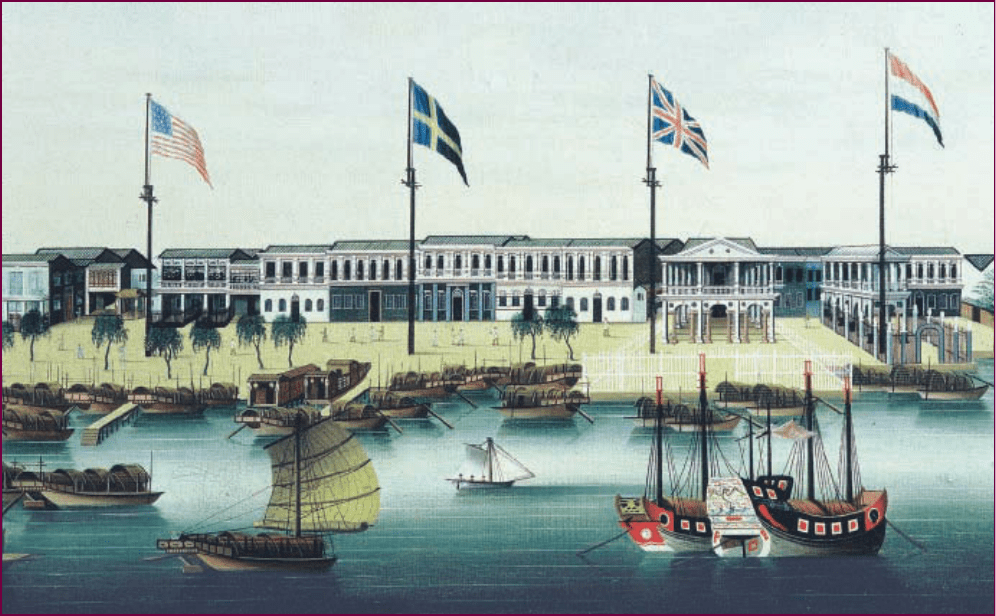
They retained the Ming political system with relatively
few changes. They also tried to establish their legitimacy
as China’s rightful rulers by stressing their devotion to the
principles of Confucianism. Emperor Kangxi ostenta-
tiously studied the sacred Confucian classics and issued a
‘‘sacred edict’’ that proclaimed to the entire empire the
importance of the moral values established by the master
(see the box on p. 427).
Still, the Manchus, like the Mongols, were ethnically,
linguistically, and culturally distinct from their subject
population. The Qing attempted to cope with this reality
by adopting a two-pronged strategy. On the one hand,
the Manchus, representing less than 2 percent of the
entire population, were legally defined as distinct from
everyone else in China. The Manchu nobles retained their
aristocratic privileges, while their economic base was
protected by extensive landholdings and revenues pro-
vided from the state treasury. Other Manchus were as-
signed farmland and organized into military units, called
banners, which were stationed as separate units in
various strategic positions throughout China. These
‘‘bannermen’’ were the primary fighting force of the
empire. Ethnic Chinese were prohibited from settling in
Manchuria and were still compelled to wear their hair in a
queue as a sign of submission to the ruling dynasty.
But while the Qing attempted to protect their dis-
tinct identity within an alien society, they also recognized
the need to bring ethnic Chinese into the top ranks of
imperial administration. Their solution was to create a
system, known as dyarchy, in which all important ad-
ministrative positions were shared equally by Chinese
and Manchus. Meanwhile, the Manchus themselves, de-
spite official efforts to preserve their separate language
and culture, were increasingly assimilated into Chinese
civilization.
China on the Eve of the Western Onslaught Unfortu-
nately for China, the decline of the Qing dynasty
occurred just as China’s modest relationship with the
West was about to give way to a new era of military
The Euro pean Wa rehouses at Canton. Aggravated by the growing presence of foreigners in the
eighteenth century, the Chinese court severely restricted the movement of European traders in China. They were
permitted to live only in a compound near Canton during the months of the trading season and could go into the
city only three times a month. In this painting, foreign flags (including, from the left, those of the United States,
Sweden, Great Britain, and Holland), fly over the warehouses and residences of the foreign community, while
Chinese sampans and junks sit anchored in the river.
c
The Art Archive/Marine Museum, Stockholm, Sweden/Gianni Dagli Orti
CHINA AT ITS APEX 415
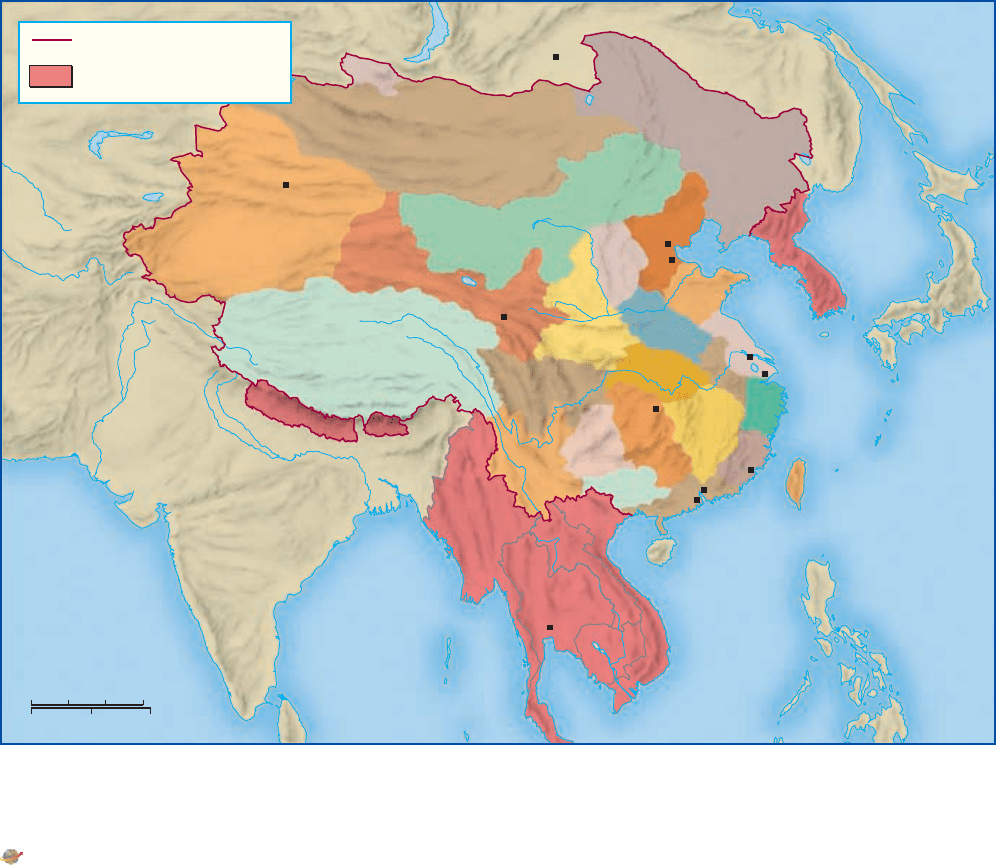
confrontation and increased pressure for trade. The first
problems came in the nor th, where Russian traders
seeking skins and furs began to penetrate the region
between Siberian Russia and Manchuria. Earlier the
Ming dynast y had attempted to deal w ith the Russians by
the traditional method of placing them in a tributary
relationship. But the tsar refused to play by Chinese
rules. His envoys to Beijing ignored the tribute system
and refused to perform the kowtow (the ritual of pros-
tration and knocking the head on the ground performed
by foreign emissaries before the emperor), the classic
symbol of fealty demanded of all foreign ambassadors to
the Chinese court. Formal diplomatic relations were fi-
nally established in 1689, when the Treaty of Nerchinsk
settled the boundary dispute and provided for regular
trade between the two countries. Through such ar-
rangements, the Manchus were able not only to pacify
the northern frontier but also to extend their rule over
Xinjiang and Tibet to the west and southwest (see
Map 17.2).
Dealing wi th the foreigners who arrived by sea was
more difficult. By the end of the seventeenth century,
th e English had replaced the Por tugue se as the domi-
nant force in European trade. Operating through the
SRI LANKA
Nanjing
Suzhou
Ayuthaya
RUSSIAN
EMPIRE
SAKHALIN
KOREA
JAPAN
TAIWAN
INDIA
BURMA
NEPAL
SIAM
VIETNAM
BHUTAN
CAMBODIA
PHILIPPINE
ISLANDS
TIBET
MANCHURIA
OUTER MONGOLIA
XINJIANG
GANSU
INNER MONGOLIA
SICHUAN
YUNNAN
GUIZHOU
SHAANXI
HUNAN
GUANGXI
GUANGDONG
FUJIAN
JIANGSU
ZHEJIANG
HENAN
SHANXI
ZHILI
SHANDONG
JIANGSU
ANHUI
HUBEI
HAINAN
LAOS
TANNU
TUVA
Macao
Canton
Beijing
Tianjin
Lanzhou
Nerchinsk
Urumchi
Changsha
Xiamen (Amoy)
H
i
m
a
l
a
y
a
M
t
s
.
Bay of
Bengal
Arabian
Sea
South
China
Sea
East
China
Sea
Sea of Japan
(East Sea)
Pacific
Ocean
G
a
n
g
e
s
R
.
I
n
d
u
s
R
.
M
e
k
o
n
g
R
.
Y
a
n
g
t
z
e
R
.
Y
e
l
l
o
w
R
.
0 250 500 Miles
0 250 500 750 Kilometers
Boundary of Qing Empire
States participating in
tributary system
MAP 17.2 The Qing Empire in the Eighte enth Centu ry. The boundaries of the Chinese
Empire at the height of the Qing dynasty in the eighteenth century are shown on this map.
Q
What areas were linked in tributary status to the Chinese Empir e, and ho w did they
benefit the empire?
View an animated version of this map or related maps at www.c engage.c om/history/
duikspiel/essentialworld6e
416 CHAPTER 17 THE EAST ASIAN WORLD

East India Com-
pany, which served
as both a trading
unit and the ad-
ministrator of En-
glish territories in
Asia, the English
established their
first trading post at
Canton in 1699.
Over the next dec-
ades, trade with
China, notably the export of tea and silk to England,
increased rapidly. To limit contact between Chinese and
Europeans, the Qing licensed Chinese trading firms at
Canton to be the exclusive conduit for trade with
the West. Eventually, the Qing confined the Europeans
to a small island just outside the city wall and per-
mitted them to reside there only from October through
March.
For a while, the British tolerated this system, but by
the end of the eighteenth century, the British government
became restive at the uneven balance of trade between the
two countries, which forced the British to ship vast
amounts of silver bullion to China in exchange for its
silks, porcelains, and teas. In 1793, a mission under Lord
Macartney visited Beijing to press for liberalization of
trade restrictions. A compromise was reached on the
kowtow (Macartney was permitted to bend on one knee
as was the British custom), but Qianlong expressed no
interest in British manufactured products (see the box
above). An exasperated Macartney compared the Chinese
Canton
city
wall
EUROPEAN
FACTORIES
P
e
a
r
l
R
i
v
e
r
Canton in the Eighteenth Century
THE TRIBUTE SYSTEM IN ACTION
In 1793, the British emissary Lord Macartney
visited the Qing Empire to request the opening
of formal diplomatic and trading relations between
his country and China. Emperor Qianlong’s reply,
addressed to King George III of Britain, illustrates how the impe-
rial court in Beijing viewed the world. King George could not
have been pleased. The document provides a good example of
the complacency with which the Celestial Empire viewed the
world beyond its borders.
A Decree of Emperor Qianlong
An Imperial Edict to the King of England: You, O King, are so
inclined toward our civilization that you have sent a special envoy
across the seas to bring to our Court your memorial of congratula-
tions on the occasion of my birthday and to present your native
products as an expression of your thoughtfulness. On perusing
your memorial, so simply worded and sincerely conceived, I am
impressed by your genuine respectfulness and friendliness and
greatly pleased.
As to the request made in your memorial, O King, to send one
of your nationals to stay at the Celestial Court to take care of your
country’s trade with China, this is not in harmony with the state
system of our dynasty and will definitely not be permitted. Tradi-
tionally people of the European nations who wished to render some
service under the Celestial Court have been permitted to come to
the capital. But after their arrival they are obliged to wear Chinese
court costumes, are placed in a certain residence, and are never
allowed to return to their own countries. This is the established rule
of the Celestial Dynasty with which presumably you, O King, are fa-
miliar. Now you, O King, wish to send one of your nationals to live
in the capital, but he is not like the Europeans who come to Peking
[Beijing] as Chinese employees, live there, and never return home
again, nor can he be allowed to go and come and maintain any
correspondence. This is indeed a useless undertaking.
Moreover the territory under the control of the Celestial Court
is very large and wide. There are well-established regulations govern-
ing tributary envoys from the outer states to Peking, giving them
provisions (of food and traveling expenses) by our post-houses and
limiting their going and coming. There has never been a precedent
for letting them do whatever they like. Now if you, O King, wish to
have a representative in Peking, his language will be unintelligible
and his dress different from the regulations; there is no place to
accommodate him. ...
The Celestial Court has pacified and possessed the territory
within the four seas. Its sole aim is to do its utmost to achieve good
government and to manage political affairs, attaching no value to
strange jewels and precious objects. The various articles presented by
you, O King, this time are accepted by my special order to the office
in charge of such functions in consideration of the offerings having
come from a long distance with sincere good wishes. As a matter of
fact, the virtue and prestige of the Celestial Dynasty having spread
far and wide, the kings of the myriad nations come by land and sea
with all sorts of precious things. Consequently there is nothing we
lack, as your principal envoy and others have themselves observed.
We have never set much store on strange or ingenious objects, nor
do we need any more of your country’s manufactures.
Q
What reasons did the emperor give for refusing Macartney’s
request to have a permanent British ambassador in Beijing?
How did the tribute system differ from the principles of interna-
tional relations as practiced in the West?
CHINA AT ITS APEX 417

Empire to ‘‘an old, crazy, first-rate man-of-war’’ that had
once awed its neighbors ‘‘merely by her bulk and ap-
pearance’’ but was now destined under incompetent
leadership to be ‘‘dashed to pieces on the shore.’’
4
With his
contemptuous dismissal of the British request, the em-
peror had inadvertently sowed the seeds for a centur y of
humiliation.
Changing China
Q
Focus Question: How did the economy and society
change during the Ming and Qing eras, and to what
degree did these chan ges seem to be leading toward an
industrial revolution on the European model?
During the Ming and Qing dynasties, China remained a
predominantly agricultural society; nearly 85 percent of
its people were farmers. But although most Chinese still
lived in rural villages, the economy was undergoing a
number of changes.
The Population Explosion
In the first place, the center of gravity was continuing to
shift steadily from the north to the south. In the early
centuries of Chinese civilization, the administrative and
economic center of gravity was clearly in the north. By the
early Qing, the economic breadbasket of China was lo-
cated along the Yangtze River and regions to the south.
One concrete indication of this shift occurred during the
Ming dynasty, when Emperor Yongle ordered the reno-
vation of the Grand Canal to facilitate the shipment of
rice from the Yangtze delta to the food-starved north.
Mor eo ver, the population was beginning to increase
rapidly (see the comparative essay ‘‘Population Explosion ’’
on p. 419). For centuries, China ’s population had remained
within a range of 50 to 100 million, rising in times of peace
and prosperity and falling in periods of for eign invasion
and internal ana rchy . During the Ming and the early Qing,
however, the population increased from an estim ated 70 to
80 million in 1390 to more than 300 million at the end of
the eighteenth century. There were probably several rea-
sons for this population in crease: the relatively long period
of peace and stabil ity under the early Qing; the introduc-
tion of new crops from the Americas, including peanut s,
sweet potatoes, and maize; and the planting of a new
species of faster-growing rice fr om Southeast Asia.
Of course, this population increase meant much
greater population pressure on the land, smaller farms,
and a razor-thin margin of safety in case of climatic di-
saster. The imperial court attempted to deal with the
problem through a variety of means, most notably by
preventing the concentration of land in the hands of
wealthy landowners. Nevertheless, by the eighteenth
century, almost all the land that could be irrigated was
already under cultivation, and the problems of rural
hunger and landlessness became increasingly serious.
Seeds of Industrialization
Another cha nge that took place during the early modern
period in China was the steady growth of manufacturing
and commerce. Taking advantage of the long era of
peace and prosperity, merchants and manufacturers
began to expand their operations beyond their imme-
diate provinces. Commercial networks began to operate
on a regional and sometimes even a national basis, as
trade in silk, metal and wood products, porcelain, cot-
ton goods, an d cash crop s like cotton and tobacco de-
veloped rapidly. Foreign trade also expanded as Chinese
merchants set up extensive contacts with countries in
Southeast Asia.
Although this rise in industrial and commercial ac-
tivity resembles the changes occurring in western Europe,
China and Europe differed in several key ways. In the first
place, members of the bourgeoisie in China were not as
independent as their European counterparts. In China,
trade and manufacturing remained under the firm con-
trol of the state. In addition, political and social preju-
dices against commercial activity remained strong.
Reflecting an ancient preference for agriculture over
manufacturing and trade, the state levied heavy taxes on
manufacturing and commerce while attempting to keep
agricultural taxes low.
One of the consequences of these differences was a
growing techn ological gap betwee n C hina and Europe.
As we have seen, China had for long been at the
CHRONOLOGY
China Dur ing the Early Modern Era
Rise of Ming dynasty 1369
Voyages of Zhenghe 1405--1433
Portuguese arrive in southern China 1514
Matteo Ricci arrives in China 1601
Li Zicheng occupies Beijing 1644
Manchus seize China 1644
Reign of Kangxi 1661--1722
Treaty of Nerchinsk 1689
First English trading post at Canton 1699
Reign of Qianlong 1736--1795
Lord Macartney’s mission to China 1793
White Lotus Rebellion 1796--1804
418 CHAPTER 17 THE EAST ASIAN WORLD
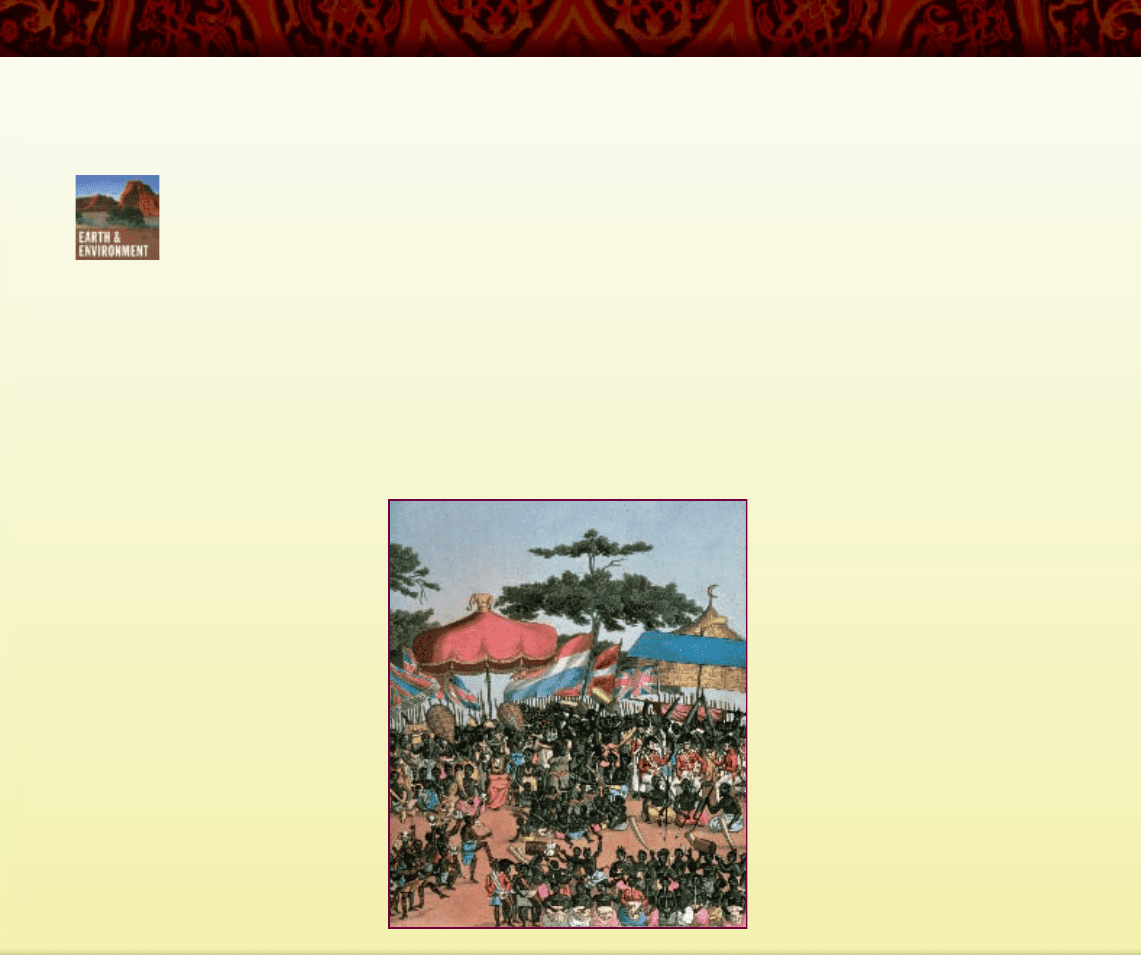
forefront of the technological revolution that was be-
ginning to transform the world in the early modern era,
but its contribution to both practical and pure science
failed to keep pace with Europe during the Qing
dynasty, when, as the historian Benjamin Elman has
noted, scholarly fashions turned back to antiquity as the
prime source for knowledge of the world of natural and
human events.
The Chinese reaction to European clockmaking
techniques provides an example. In the early seventeenth
century, the Jesuit Matteo Ricci introduced advanced
European clocks driven by weights or springs. The em-
peror was fascinated and found the clocks more reliable
than Chinese methods of keeping time. Over the next
decades, European timepieces became a popular novelty
at court, but the Chinese expressed little curiosity about
the technology involved, provoking one European to re-
mark that playthings like cuckoo clocks ‘‘will be received
here with much greater interest than scientific instru-
ments or objets d’art.’’
5
Daily Life in Qing China
Daily life under the Ming and early Qing dynasties
continued to follow traditional patterns. As i n earlier
periods, Chinese society was organized around the
family. The ideal family unit in Qing China was the jo int
family, in which as many as three or even four
COMPARATIVE ESSAY
T
HE POPULATION EXPLOSION
Between 1700 and 1800, Europe, China, and, to
a lesser degree, India and the Ottoman Empire
experienced a dramatic growth in population. In
Europe, the population grew from 120 million
people to almost 200 million by 1800; China, from less than
200 million to 300 million during the same period.
Four factors were important in causing this population explosion.
First, better growing conditions, made possible by an improvement
in climate, affected wide areas of the world and enabled people to
produce more food. Summers in both China and Europe became
warmer beginning in the early eighteenth century. Second, by the
eighteenth century, people had begun to develop immunities to the
epidemic diseases that had caused such
widespread loss of life between 1500 and
1700. The movements of people by ship
after 1500 had led to devastating epi-
demics. For example, the arrival of Euro-
peans in Mexico introduced smallpox,
measles, and chicken pox to a native
population that had no immunities to
European diseases. In 1500, between 11
and 20 million people lived in the area
of Mexico; by 1650, only 1.5 million
remained. Gradually, however, people
developed immunities to these diseases.
A third factor in the population
increase came from new food sources.
As a result of the Columbian exchange
(see the box on p. 344), American food
crops---such as corn, potatoes, and
sweet potatoes---were carried to other
parts of the world, where they became important food sources.
China had imported a new species of rice from Southeast Asia that
had a shorter harvest cycle than that of existing varieties. These new
foods provided additional sources of nutrition that enabled more
people to live for a longer time. At the same time, land development
and canal building in the eighteenth century also enabled govern-
ment authorities to move food supplies to areas threatened with
crop failure and famine.
Finally, the use of new weapons based on gunpowder allowed
states to control larger territories and maintain a new degree of
order. The early rulers of the Qing dynasty, for example, pacified the
Chinese Empire and ensured a long period of peace and stability.
Absolute monarchs achieved similar goals in a number of European
states. Thus, deaths from violence were de-
clining at the same time that an increase
in food supplies and a decrease in deaths
from diseases were occurring, thereby
making possible in the eighteenth century
the beginning of the world population ex-
plosion that persists to this day.
Q
What were the main reasons for the
dramatic expansion in the world popula-
tion during the early modern era?
c
British Museum/The Bridgeman Art Library
Festival of the Yam. The spread of a
few major food crops made possible new
sources of nutrition to feed more people.
The importance of the yam to the Ashanti
people of West Africa is evident in this
celebration of a yam festival at harvest time
in 1817.
CHANGING CHINA 419
generations lived under the same roof. When sons
marri ed, they brought their wives to live with them in
the family homestead. Unmarried daughters would also
remain in the house. Aging parents and grandparents
remaine d un der the same roof and were cared for by
younger members of the household until they died. This
ideal did not always correspond to reality, however, since
many families did not possess sufficient land to support
a large household.
The Family The family continued to be important in
early Qing times for much the same reasons as in earlier
times. As a labor-intensive society based primarily on
the cultivation of rice, China needed large families to
help w ith the harvest and to provide security for parents
too old to work in the fields. Sons were par ticularly
prized, not only because they had strong backs but also
because they would raise their own families under the
parental roof. With few opportunities for employment
outside the family, sons had little choice but to remain
with their parents and help on the land. Within the
family, the oldest male was king , and his w ishes theo-
retically had to be obeyed by all family members.
Marriages were normally arranged for the benefit of the
family, often by a go-between, and the groom and bride
usually were not consulted. Frequently, they did not
meet until the marriage ceremony. Under such con-
ditions, love was clearly a secondar y consideration. In
fact, it was often viewed as detrimental since it inevi-
tably distracted the attention of the husband and wife
from their primar y responsibility to the larger family
unit.
Although this emphasis on filial piety might seem
to represent a blatant disregard for indiv idual rights, the
obligations were not all on the side of the children. The
father was expected t o provide support for his wife and
children and, like the ruler, was supposed to treat t hose
inhiscarewithrespectandcompassion.Alltoooften,
however, the male head of the family was able to exact
his privileges without performing his responsibilities in
return.
Beyond t he join t family was the clan. Sometimes
called a lineage, a clan was an extended kinship unit
consist ing of dozens or even hun dreds of joint and
nuclear families linked together by a clan council of
elders and a variety of other common social and reli-
gious f unctions. T he clan served a number of useful
purposes. Some clans possessed lands that could be
rented out to poorer families, or richer families w ithin
the clan might provide land for the poor. S ince there was
no g eneral state-supported educational syste m, sons of
poor families might be invited to study in a school
established in the home of a more prosperous relative.
If the young man succeeded in becoming an official, he
would be expected to provide favors and prestige for the
clan as a whole.
The Role of Women In traditional China, the role of
women had always been inferi or to that of men. A
six teenth-century Spanish visitor to South China ob-
served that Chinese women were ‘‘very secluded and
vir tuous, and it was a very rare thing for us to see a
woman in the cities and large towns, unless it was an old
crone.’’ Women were more visible, he said, in rural areas,
where they frequently could be seen working in the
fields.
6
The concept of female infe riority had deep roots in
Chinese history. Thi s view was embodied in the belief
that only a male would ca rry on sacred family rituals and
that men alone had the talent to govern others. Only
males could aspire to a career in government or schol-
arship. Within the family system, the wife w as clearly
subordinated to the husband. Legally, she could not
divorce her husband or in herit property. The husband,
however, could divorce his wife if she did not produce
male heirs, or he could take a second wife as well as a
concubine for his pleasure. A widow suffered especially,
because she had to either raise her child ren on a single
income or fight off her former husband’s greedy rela-
tives, who would coe rce her to remarry sin ce, by law,
they would then inherit all of her previous property an d
her original dowry.
Female children were less desirable because of their
limited physical strength and because a girl’s parents
would have to pay a dowry to the parents of her future
husband. Female children normally did not receive an
education, and in times of scarcity when food was in
short supply, daughters might even be put to death.
Though women were clearly inferior to men in the-
ory, this was not always the case in practice. Capable
women often compensated for their legal inferiority by
playing a strong role within the family. Women were
often in charge of educating the children and handled
the family budget. Some privileged women also received
training in the Confucian classics, although their school-
ing was generally for a shorter time and less rigorous than
that of their male counterparts. A few produced signifi-
cant works of art and poetry.
Cultural Developments
During the late Ming and the early Qing dynasties,
traditional culture in China reached new heig hts of
achievement. With the rise of a wealthy urban class, the
demand for art, porcelain, textiles, and literature grew
significantly.
420 CHAPTER 17 THE EAST ASIAN WORLD
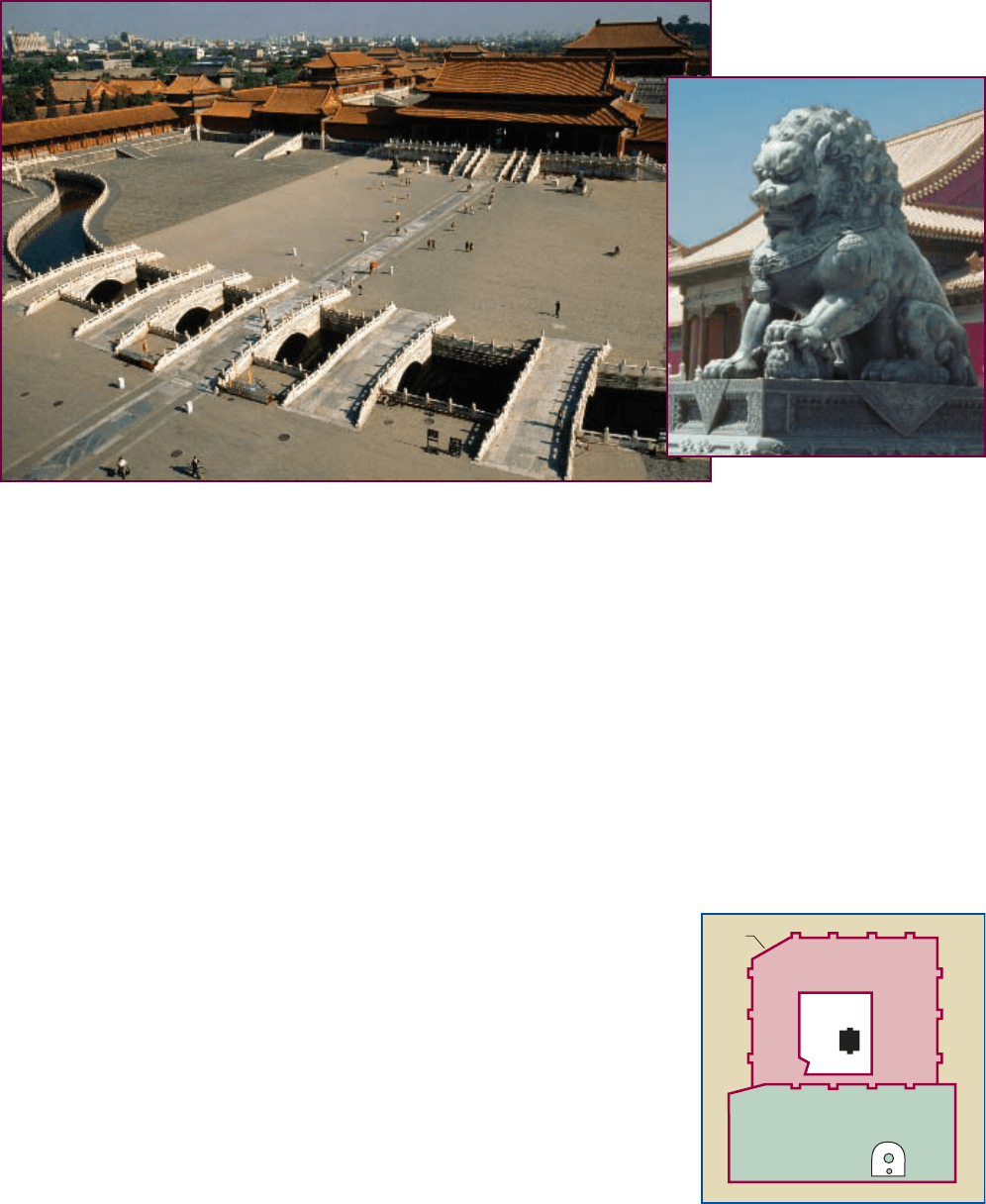
The Rise of the Chinese Novel During the Ming dy-
nasty, a new form of literature appeared that eventually
evolved into the modern Chinese novel. Although con-
sidered less respectable than poetry and nonfiction prose,
these groundbreaking works (often written anonymously
or under pseudonyms) were enormously popular, espe-
cially among well-to-do urban dwellers.
Written in a colloquial style, the new fiction was
characterized by a realism that resulted in vivid portraits
of Chinese society. Many of the stories sympathized with
society’s downtrodden---often helpless maidens---and
dealt with such crucial issues as love, money, marriage,
and power. Adding to the realism were sexually explicit
passages that depicted the private side of Chinese life.
Readers delighted in sensuous tales that, no matter how
pornographic, always professed a moral lesson; the vil-
lains were punished and the virtuous rewarded.
The Dr eam of the Red Chamber is generally considered
China’s most distinguished popular novel. Published in
1791, it tells o f the tragic love between two young people
caught in the financial and moral dis integration of a
powerful Chinese clan. The hero and the heroine, both
sensitive and spoiled, represent the inevitable decline of the
Chia family and come to an equally inevitable tragic end,
she in death an d he in an unhappy marriage to another.
The Art of the Ming and the Qing During the Ming
and the early Qing, China produced its last outpouring of
traditional artistic brilliance. Although most of the crea-
tive work was modeled on past examples, the art of this
period is impressive for its technical perfection and
breathtaking quantity.
In architecture, the m ost outstandin g example is the
Imperial City in Beijing. Building on the remnants of
the palace of the Yuan dynasty, the Mi ng emperor
Yongle ordered renovations when he returned the capital
to Beijing in 1421.
Succeeding emper-
ors continued to
add to the palace,
but the basic design
has n ot changed
since the Ming
era. Surrounded by
high walls, the im-
mense compound
is div ided into a
maze of private
apartments and of-
fices and a n im-
posing ceremonial
The Imp erial City in Be ijing. During the fifteenth century, the Ming dynasty erected an immense
imperial city on the remnants of the palace of Khubilai Khan in Beijing. Surrounded by 6½ miles of walls, the
enclosed compound is divided into a maze of private apartments and offices; it also includes an imposing
ceremonial quadrangle with stately halls for imperial audiences and banquets. Because it was off-limits to
commoners, the compound was known as the Forbidden City. The fearsome lion shown in the inset,
representing the omnipotence of the Chinese Empire, guards the entrance to the private apartments of
the palace.
c
William J. Duiker
Imperial
City
Palace
Temple of
Heaven
City
wall
INNER CITY
OUTER CITY
Beijing Under the Ming and the
Manchus, 1400–1911
c
Michael S. Yamashita/National Geographic/Getty Images
CHANGING CHINA 421
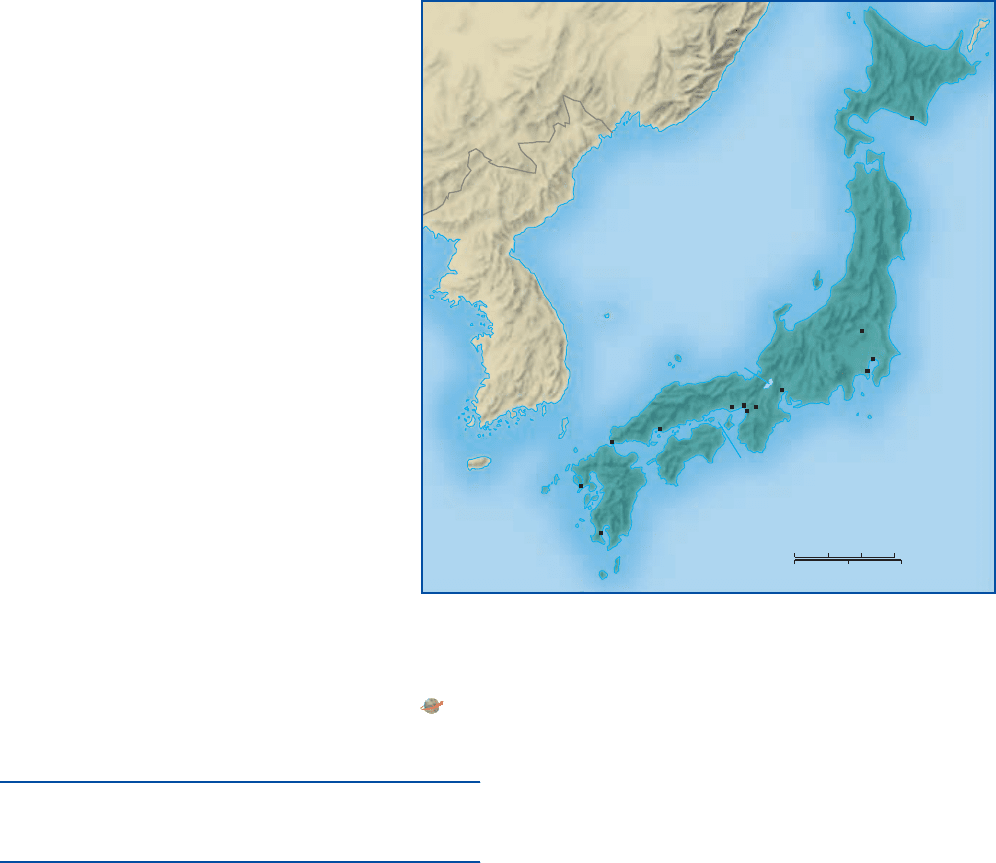
quadrangle with a series of stately halls f or
imperial audiences and banquets. The gran-
diose scale, richly carved marble, spacious
gardens, and graceful upturned roofs also
contribute to the splendor of the ‘‘Forbidden
City.’’
The decorative arts flourished in this pe-
riod, especially the intricately car ved lac-
querware and the boldly shaped and colored
cloisonn
e, a type of enamelwork in which
colored areas are separated by thin metal
bands. Silk production reached its zenith, and
the best-qualit y silks were hig hly prized in
Europe, where chinoiserie, as Chinese art of
all kinds was called, was in vogue. Perhaps
themostfamousofalltheachievementsof
the Ming era was its blue-and-white porce-
lain, still prized by collectors throughout the
world.
During the Qing dynasty, artists produced
great quantities of paintings, mostly for home
consumption. Inside the Forbidden City in
Beijing, court painters worked alongside Jesuit
artists and experimented with Western tech-
niques. Most scholarly painters and the literati,
however, totally rejected foreign techniques
and became obsessed with traditional Chinese
styles. As a result, Qing painting became pro-
gressively more repetitive and stale.
Tokugawa Japan
Q
Focus Question: How did the society and economy of
Japan change during the Tokugawa era, and how did
Japanese culture reflect those changes?
At the end of the fifteenth century, the traditional Japa-
nese system was at a point of near anarchy. With the
decline in the authority of the Ashikaga shogunate at
Kyoto, clan rivalries had exploded into an era of warring
states. Even at the local level, power was frequently dif-
fuse. The typical daimyo (great lord) domain had often
become little more than a coalition of fief-holders held
together by a loose allegiance to the manor lord. Never-
theless, Japan was on the verge of an extended era of
national unification and peace under the rule of its
greatest shogunate---the Tokugawa.
The Three Great Unifiers
The process began in the mid-sixteenth century with
the emergence of three very powerful political figures,
Oda Nobunaga (1568--1582), Toyotomi Hideyoshi (1582--
1598), and Tokugawa I eyasu (1598--1616). In 1568, Oda
Nobunaga, the son of a samurai and a military com-
mander under the Ashikaga shogunate, seized the im-
perial capital of Kyoto and placed the reigning shogun
under his domination. During the next few years, the
brutal and ambitious Nobunaga attempted to consoli-
date his rule throughout the central plains by defeating
his rivals and suppressing the power of the Buddhist
estates, but he was killed by one of his generals in 1582
before the process was complete. He was succeeded by
Toyotomi Hideyoshi, a farmer’s son who had worked
his way up through the ranks to become a militar y
commander. Hideyoshi located his capital at Osaka,
where he built a castle to accommodate his headquar-
ters, and gradually extended his power outward to
the southern islands of Shikoku and Kyushu (see
Map 17.3). By 1590, he had persuaded most of the
daimyo on the Japanese islands to accept his authority
and created a national currency. Then he invaded Korea
Sea of Japan
(East Sea)
East
China
Sea
Pacific
Ocean
Tsushima
Kyushu
Honshu
Shikoku
Hokkaido
Kanto
Plain
Nagasaki
Kagoshima
Shimonoseki
Hiroshima
Kobe
Himeji
Kyoto
Osaka
Nagoya
Yokohama
Edo
Nikko
Hakodate
CHINA
KOREA
Inland
Sea
Lake
Biwa
0 100 200 Miles
0 200100 300 Kilometers
MAP 17.3 Toku gawa Japa n. This map shows the Japanese islands
during the long era of the Tokugawa shogunate. Key cities, including the
shogun’s capital of Edo, are shown.
Q
Wher e was the imperial c ourt located?
View an animated version of this map or related maps at
www .cengage.com/history/duikspiel/essentialworld6e
422 CHAPTER 17 THE EAST ASIAN WORLD
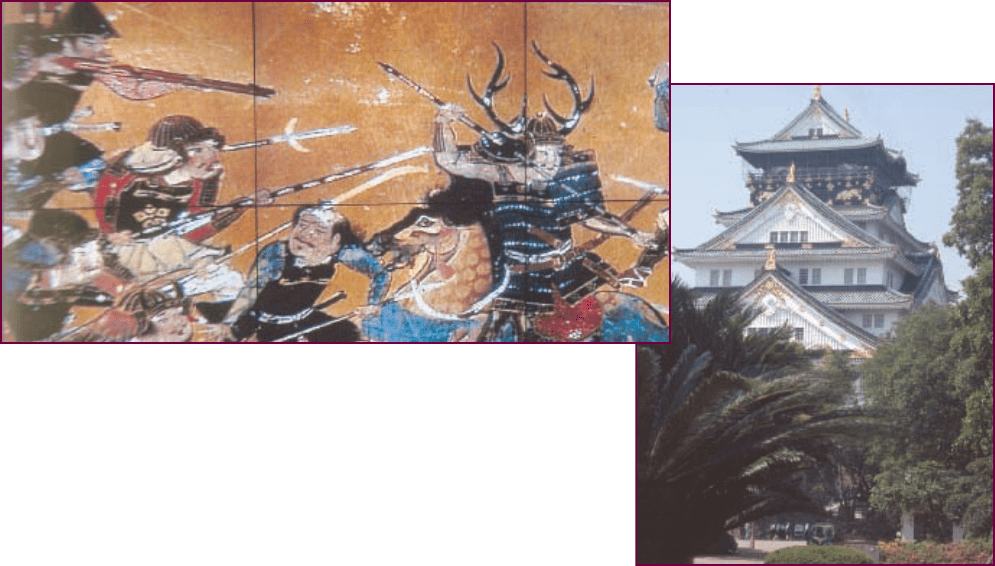
in an abor tive effort to expor t his rule to the Asian
mainland.
Despite their efforts, however, neither Nobunaga nor
Hideyoshi was able to eliminate the power of the local
daimyo. Both were compelled to form alliances with some
daimyo in order to destroy other more powerful rivals. At
the conclusion of his conquests in 1590, Toyotomi
Hideyoshi could claim to be the supreme proprietor of all
registered lands in areas under his authority. But he then
reassigned those lands as fiefs to the local daimyo, who
declared their allegiance to him. The daimyo in turn
began to pacify the countryside, carrying out extensive
‘‘sword hunts’’ to disarm the population and attracting
samurai to their service. The Japanese tradition of de-
centralized rule had not yet been overcome.
After Hideyoshi’s death in 1598, Tokugawa Ieyasu,
the powerful daimyo of Edo (modern Tokyo), moved to
fill the vacuum. Neither Hideyoshi nor Oda Nobunaga
had claimed the title of shogun, but Ieyasu named himself
shogun in 1603, initiating the most powerful and long-
lasting of all Japanese shogunates. The Tokugawa rulers
completed the restoration of central authority begun by
Nobunaga and Hideyoshi and remained in power until
1868, when a war dismantled the entire system. As a
contemporary phrased it, ‘‘Oda pounds the national rice
cake, Hideyoshi kneads it, and in the end Ieyasu sits down
and eats it.’’
7
Opening to the West
The unification of Japan took place almost simultaneously
with the coming of the Europeans. Portuguese traders
sailing in a Chinese junk that may have been blown off
course by a typhoon had landed on the islands in 1543.
Within a few years, Portuguese ships were stopping at
Japanese ports on a regular basis to take part in the re-
gional trade between Japan, China, and Southeast Asia.
The first Jesuit missionary, Francis Xavier, arrived in 1549.
Initially, the visitors were welcomed. The curious
Japanese were fascinated by tobacco, clocks, spectacles,
and other European goods, and local daimyo were in-
terested in purchasing all types of European weapons and
armaments. Oda Nobunaga and Toyotomi Hideyoshi
found the new firearms helpful in defeating their enemies
and unifying the islands. The effect on Japanese military
architecture was particularly striking as local lords began
to erect castles on the European model, many of which
still exist today.
The missionaries also had some success in converting
a number of local daimyo, some of whom may have been
motivated in part by the desire for commercial profits. By
the end of the sixteenth century, thousands of Japanese in
the southernmost islands of Kyushu and Shikoku had
become Christians. But papal claims to the loyalty of all
Japanese Christians and the European habit of intervening
The Sie ge of Osaka Cast le. In imitation of European castle architecture, the Japanese
perfected a new type of fortress-palace in the early seventeenth century. Strategically placed
high on a hilltop, constructed of heavy stone with tiny windows, and fortified by numerous
watchtowers and massive walls, these strongholds were impregnable to arrows and catapults.
They served as a residence for the local daimyo, while the castle compound also housed his
army and contained the seat of the local government. Osaka Castle (on the right) was built by
Hideyoshi essentially as a massive stage set to proclaim his power and grandeur. In 1615, the
powerful warlord Tokugawa Ieyasu seized the castle, as shown in the screen painting above.
The family’s control over Japan lasted nearly 250 years. Note the presence of firearms,
introduced by the Europeans half a century earlier.
c
William J. Duiker
c
William J. Duiker
TOKUGAWA JAPAN 423
